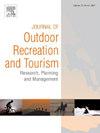The spatial network structure of the U.S. outdoor recreation economy and its influencing factors
IF 3.6
3区 管理学
Q1 HOSPITALITY, LEISURE, SPORT & TOURISM
Journal of Outdoor Recreation and Tourism-Research Planning and Management
Pub Date : 2025-04-12
DOI:10.1016/j.jort.2025.100878
引用次数: 0
Abstract
Investigating the spatial network structure of the outdoor recreation economy has significant implications for the industrial layout of outdoor recreation economies in other countries. However, there is a notable lack of research on this topic. Therefore, this study explores the spatial network structure of the U.S. outdoor recreation economy using a modified gravity model and social network analysis (SNA), and employs QAP analysis to examine its influencing factors. The findings reveal the following: (1) COVID-19 significantly hindered the overall development of the U.S. outdoor recreation economy, reducing economic cooperation among states; however, recovery has been relatively swift. (2) Coastal regions exhibit significant developmental advantages in outdoor recreation economies. (3) The study confirms prior assumptions that, while the U.S. outdoor recreation economy demonstrated low short-term resilience following global public health events, it exhibited high long-term resilience. During the initial outbreak of COVID-19, people tended to seek relatively safer and less crowded areas. (4) The Mid-Atlantic, Southeastern, Upper Mississippi Valley, and Pacific Coast regions showed significant economic siphon effects, whereas the Midwest and Rocky Mountain regions exhibited notable economic spillover effects. States like California, Colorado, and New York play pivotal roles as intermediaries and hubs in the flow of outdoor recreation elements.(5) The QAP analysis results reveal that factors such as temperature, precipitation, and income levels significantly influence the network structure. Additionally, economic coordination among regions, optimized resource allocation, and the development of climate-resilient infrastructure play crucial roles in enhancing network resilience and promoting balanced regional development.
美国户外娱乐经济的空间网络结构及其影响因素
研究户外休闲经济的空间网络结构对其他国家户外休闲经济的产业布局具有重要意义。然而,这方面的研究明显不足。因此,本研究利用修正的引力模型和社会网络分析(SNA)对美国户外休闲经济的空间网络结构进行了探讨,并采用QAP分析方法对其影响因素进行了研究。研究结果表明(1)COVID-19 严重阻碍了美国户外休闲经济的整体发展,减少了各州之间的经济合作,但恢复相对较快。(2)沿海地区在户外休闲经济发展方面表现出明显的优势。(3)研究证实了之前的假设,即虽然美国户外休闲经济在全球公共卫生事件后表现出较低的短期恢复能力,但却表现出较高的长期恢复能力。在 COVID-19 最初爆发期间,人们倾向于寻找相对更安全、人更少的地区。(4) 大西洋中部、东南部、密西西比河上游和太平洋沿岸地区表现出显著的经济虹吸效应,而中西部和落基山地区则表现出明显的经济溢出效应。加利福尼亚、科罗拉多和纽约等州在户外娱乐要素流动中扮演着中介和枢纽的重要角色。此外,区域间的经济协调、资源的优化配置以及气候适应性基础设施的发展,对于增强网络的适应性和促进区域的平衡发展也起着至关重要的作用。
本文章由计算机程序翻译,如有差异,请以英文原文为准。
求助全文
约1分钟内获得全文
求助全文
来源期刊

Journal of Outdoor Recreation and Tourism-Research Planning and Management
HOSPITALITY, LEISURE, SPORT & TOURISM-
CiteScore
6.70
自引率
5.30%
发文量
84
期刊介绍:
Journal of Outdoor Recreation and Tourism offers a dedicated outlet for research relevant to social sciences and natural resources. The journal publishes peer reviewed original research on all aspects of outdoor recreation planning and management, covering the entire spectrum of settings from wilderness to urban outdoor recreation opportunities. It also focuses on new products and findings in nature based tourism and park management. JORT is an interdisciplinary and transdisciplinary journal, articles may focus on any aspect of theory, method, or concept of outdoor recreation research, planning or management, and interdisciplinary work is especially welcome, and may be of a theoretical and/or a case study nature. Depending on the topic of investigation, articles may be positioned within one academic discipline, or draw from several disciplines in an integrative manner, with overarching relevance to social sciences and natural resources. JORT is international in scope and attracts scholars from all reaches of the world to facilitate the exchange of ideas. As such, the journal enhances understanding of scientific knowledge, empirical results, and practitioners'' needs. Therefore in JORT each article is accompanied by an executive summary, written by the editors or authors, highlighting the planning and management relevant aspects of the article.
 求助内容:
求助内容: 应助结果提醒方式:
应助结果提醒方式:


